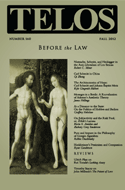James Hellings’s “Messages in a Bottle and Other Things Lost to the Sea: The Other Side of Critical Theory or a Reevaluation of Adorno’s Aesthetic Theory” appears in Telos 160 (Fall 2012). Read the full version online at the Telos Online website, or purchase a print copy of the issue here.
 Drawing on a range of modern and contemporary works of art and literature (Edgar Allan Poe, Caspar David Friedrich, Bas Jan Ader, Tacita Dean), this essay seeks to exaggerate the aesthetic side of Adorno’s critical theory, re-evaluating the latter through a detailed analysis of the image of messages in a bottle. In overturning and displacing the critical genealogy of this image and in anchoring it to the construction of Adorno’s aesthetic and the work of art, I challenge the so-called “prevalent view” that transforms Adorno’s image into a pejorative logo for his alleged withdrawal into political quietism, pessimism, and resignation: a “strategy of hibernation.” Neither the critical theorists nor the activist critics of the Frankfurt School, I argue, have exclusivity over the image of messages in a bottle. If art is “the surviving message of despair from the shipwrecked,” then the work of art in Adorno’s aesthetics best expresses the paradox of engagement through disengagement, which itself translates Adorno’s standpoint on social praxis. Art turns socio-political, as with Friedrich’s Rückenfiguren, by turning away. Adorno valued radical new art for its distancing effect, for its great refusal, for becoming society’s Other. Art works well when complex antagonistic fragments crystallize into a force field, confronting, critiquing, and transforming the damaged life of society. Art, like the bottle of messages, is a container for truth and hope addressed to imaginary witnesses of an uncertain future, sent in spite of the aggressive indifference of the world, and aesthetics becomes, here at least, the privileged other of critical theory.
Drawing on a range of modern and contemporary works of art and literature (Edgar Allan Poe, Caspar David Friedrich, Bas Jan Ader, Tacita Dean), this essay seeks to exaggerate the aesthetic side of Adorno’s critical theory, re-evaluating the latter through a detailed analysis of the image of messages in a bottle. In overturning and displacing the critical genealogy of this image and in anchoring it to the construction of Adorno’s aesthetic and the work of art, I challenge the so-called “prevalent view” that transforms Adorno’s image into a pejorative logo for his alleged withdrawal into political quietism, pessimism, and resignation: a “strategy of hibernation.” Neither the critical theorists nor the activist critics of the Frankfurt School, I argue, have exclusivity over the image of messages in a bottle. If art is “the surviving message of despair from the shipwrecked,” then the work of art in Adorno’s aesthetics best expresses the paradox of engagement through disengagement, which itself translates Adorno’s standpoint on social praxis. Art turns socio-political, as with Friedrich’s Rückenfiguren, by turning away. Adorno valued radical new art for its distancing effect, for its great refusal, for becoming society’s Other. Art works well when complex antagonistic fragments crystallize into a force field, confronting, critiquing, and transforming the damaged life of society. Art, like the bottle of messages, is a container for truth and hope addressed to imaginary witnesses of an uncertain future, sent in spite of the aggressive indifference of the world, and aesthetics becomes, here at least, the privileged other of critical theory.


